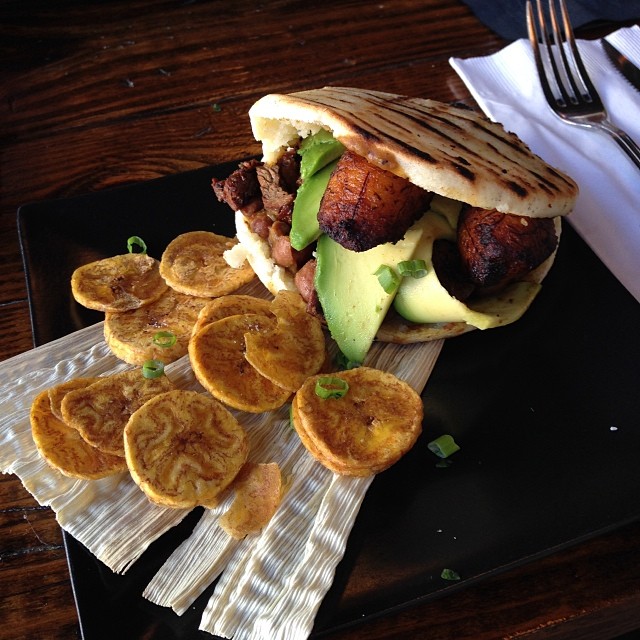We Maracuchos are extremely proud of our city and our traditions despite all the political, economic, and social challenges we face. In New Orleans, we cook traditional Venezuelan food every week at my house. The fastest and most common Venezuelan dish is called arepas. The arepa is a flat, round patty made out of corn flour, water, and salt. Arepas can be grilled, baked, fried, boiled, or steamed. They’re split in half and filled with different types of meat, vegetables, grains, plantains, cheese, etc.
When I went to Japan in the summer of 2016 through the UNO Study Abroad program, I took several packets of Harina Pan, the pre-cooked corn flour used to make arepas, with me. One night, some of my classmates showed interest in trying them out. While they ate the arepas, most of them started asking questions about Maracaibo and Venezuela. It felt amazing to cook traditional Venezuelan food for Americans studying abroad in Japan. It felt even better to see how food was drawing a connection between our cultures.

The Venezuelan arepa in New Orleans. Photo under Creative Commons license by Charles Barilleaux.
Our country has very distinct flavors. Whenever we invite friends over, I like to cook Venezuelan food for them. I feel that it is important to share our culture with our friends in every way that we can. Ultimately, that’s what defines us and make us who we are.
Christmas is my favorite time of the year because it is during this time that we listen to gaitas. The gaita is a style of Venezuelan folk music from Maracaibo. Song themes range from humorous stories about how hot Maracaibo is, our delicious street food, love, protests against the government, and most importantly, religion.
There are hundreds, if not thousands, of gaitas dedicated to Our Lady of the Rosary of Chiquinquirá or the Virgin of Chiquinquirá, our patron saint. Maracuchos celebrate her apparition every year in the month of November with parties all over the city. Maracaibo is decorated with Christmas lights, stages sponsored by the government and private companies are set up, and gaita concerts are held every week until November 18. Hundreds of people, from both Maracaibo and other cities, stay up all night and celebrate in her honor. After November 18, the gaitas continue to resonate until the end of Christmas. I love gaitas because I grew up listening to them, to the stories of my people. My sister Loraine explains why gaitas are so important for Maracuchos:
Gaitas are very special because they talk about the reality of our city and our country. Government propaganda usually hides a lot of terrible things that happen in Venezuela. Gaitas, however, have no filter. They’re a tool for people to express their true feelings regarding our struggles and the challenges that we face as Maracuchos and Venezuelans.
I also have a deep appreciation for this music style because my father loved it. The last Christmas I spent with him was full of joy, laughter, and gaitas. After my father committed suicide in January of 2006, I spent several years without listening to gaitas. When I look back at that last Christmas with him, I do so with nostalgia but also with joy. Every year, starting on the first days of November, I start listening to gaitas. They’re a way for me to remember my father in his good days.
Maracaibo tierra amada / Maracaibo beloved land
Desde que de ti salí / Ever since I left you
A cada instante te añoro / I miss you every now and then
Me paso el tiempo / I spend my time
pensando en ti / thinking of you
Y en mi vibra la esperanza / And within me there is hope
Que a ti voy a regresar / that someday I will go back to you.
 Waves of Change–The Impact of Political Tides on Louisiana’s Environmental Future
Healthy Gulf has been a cornerstone in safeguarding Louisiana’s natural and human resources through sustainable and equitable practices. But a new threat looms with Governor Jeff Landry’s recent consolidation proposal, which aims to merge crucial coastal management with the Department of Energy and Natural Resources. Writer Leah Claman delves into the complexities of this proposal, breaking it down for those unfamiliar with environmental policy, and sheds light on what this could mean for the future of Louisiana’s coast and its communities.
Waves of Change–The Impact of Political Tides on Louisiana’s Environmental Future
Healthy Gulf has been a cornerstone in safeguarding Louisiana’s natural and human resources through sustainable and equitable practices. But a new threat looms with Governor Jeff Landry’s recent consolidation proposal, which aims to merge crucial coastal management with the Department of Energy and Natural Resources. Writer Leah Claman delves into the complexities of this proposal, breaking it down for those unfamiliar with environmental policy, and sheds light on what this could mean for the future of Louisiana’s coast and its communities.
 Earthtalk: Retaining starts with repurposing – Green Light New Orleans
This piece spotlights Green Light New Orleans, a non-profit dedicated to promoting collective engagement in sustainability practices in local households. Author Brett Steinberg discusses the non-profit's Rain Barrel program, effectively combining art and water conservation.
Earthtalk: Retaining starts with repurposing – Green Light New Orleans
This piece spotlights Green Light New Orleans, a non-profit dedicated to promoting collective engagement in sustainability practices in local households. Author Brett Steinberg discusses the non-profit's Rain Barrel program, effectively combining art and water conservation.
